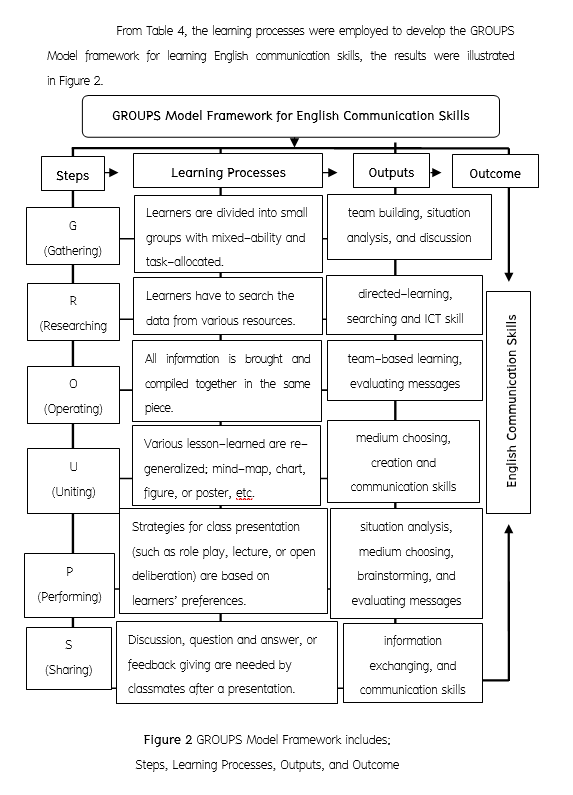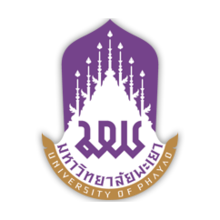การพัฒนา GROUPS Model สำหรับการเรียน ทักษะการสื่อสารภาษาอังกฤษ มหาวิทยาลัยราชภัฏกำแพงเพชร แม่สอด
คำสำคัญ:
ทักษะการสื่อสารภาษาอังกฤษ, การเรียนรู้ภาษาอังกฤษ, กรุ๊ปส์ โมเดลบทคัดย่อ
งานวิจัยนี้มีวัตถุประสงค์ 1) เพื่อพัฒนา GROUPS Model สำหรับการเรียนทักษะการสื่อสารภาษาอังกฤษ 2) เพื่อศึกษาประสิทธิภาพของ GROUPS Model ในการพัฒนาทักษะการสื่อสารภาษาอังกฤษของนักศึกษา และ 3) เพื่อศึกษาความพึงพอใจของนักศึกษาที่มีต่อ GROUPS Model มหาวิทยาลัยราชภัฏกำแพงเพร แม่สอด ประชากรมี 2 กลุ่ม ได้แก่ กลุ่มแรก สำหรับขั้นประเมินความต้องการ ประกอบด้วย ผู้เชี่ยวชาญจากมหาวิทยาลัยต่าง ๆ 11 คน นักศึกษาเอกภาษาอังกฤษ 256 คน และบัณฑิตเอกภาษาอังกฤษ 124 คน ของมหาวิทยาลัยราชภัฏกำแพงเพชร ครูสอนภาษาอังกฤษ 51 คน และ นายจ้าง 71 คน ในเขตอำเภอแม่สอด จังหวัดตาก โดยใช้วิธีการสุ่มแบบง่ายและเลือกแบบตามสะดวก กลุ่มที่สอง สำหรับขั้นการศึกษานำร่อง มี 35 คน ได้แก่ นักศึกษาเอกการบัญชี 18 คน และเอกภาษาอังกฤษ 17 คน โดยใช้วิธีการสุ่มแบบง่าย ในภาคเรียนที่ 2/2559 มหาวิทยาลัยราชภัฏกำแพงเพชร แม่สอด เครื่องมือที่ใช้คือ แบบประเมินความต้องการ แบบประเมินผลสัมฤทธิ์และแบบสอบถาม วิเคราะห์ข้อมูล
เชิงปริมาณโดยด้วยการหาค่าเฉลี่ยและส่วนเบี่ยงเบนมาตรฐาน และข้อมูลเชิงคุณภาพใช้การวิเคราะห์เชิงเนื้อหา ผลการวิจัยดังนี้ 1) การพัฒนา GROUPS Model พบว่าการประเมินความต้องการด้านทักษะการสื่อสารภาษาอังกฤษภาพรวมอยู่ในระดับมาก (ค่าเฉลี่ย=3.56) และความคิดเห็นของผู้เชี่ยวชาญที่มีต่อ GROUPS Model และแผนการสอนอยู่ในระดับเหมาะสมมากที่สุด (ค่าเฉลี่ย=4.44 และ ค่าเฉลี่ย 4.47) ตามลำดับ 2. ผลการศึกษาประสิทธิภาพของ GROUPS Model พบว่า คะแนนผลสัมฤทธิ์ GROUPS Model ของผู้เรียนภาพรวมอยู่ในระดับดี (ค่าเฉลี่ย15.31) สำหรับผลสัมฤทธิ์การนำเสนอภาษาอังกฤษภาพรวมอยู่ในระดับดี (ค่าเฉลี่ย16.81) 3. ผลการศึกษาความพึงพอใจของนักศึกษาที่มีต่อ GROUPS Model ภาพรวมอยู่ในระดับสูง (ค่าเฉลี่ย=3.63)
เอกสารอ้างอิง
Bull, S., & Ma, Y. (2001). Raising Learner Awareness of Language Learning Strategies in Situations of Limited Resources.Interactive Learning Environments, 9, 171-200. DOI:10.1076/ ilee.9.2.171.7439
Chairinkum, B. (2003). The Development of Standard-Based Technical English Course in Auto-Mechanics for the Lower Certificate Level of Vocational Education. Doctor of Philosophy (Curriculum and Instruction), Department of Education, Kasetsart University, Bangkok.
Chan-ocha, P. (2014). The Policy Statement of the Council of Ministers Gen. Prayuth Chan-ocha, the Prime Minister told the National Assembly. Bangkok: Cabinet and Royal Gazette Publishing Office Press.
Chitnukulsiri, P. (2014). The Communication Process of Volunteer Spirit of Taiwanese Tzu Chi Organization in a Viewpoint of Thai Leaders and Their Application in Promoting Volunteer Spirit in Thailand. Master of Arts (Mass Communication) Program in Communication Arts, Faculty of Communication Arts,Chulalongkorn University, Bangkok.
Hua, Huang Xiao. (1985). Chinese EFL Students’ Learning Strategies for communication. TESOL Quarterly journal, 19 (1), 167-168.
Johnson, D. W. and Johnson, R. T. (1991). Learning together and alone: Cooperative, competitive, and individualistic learning. Prentice-Hall, Inc.
Johnson, D. W., Johnson, R. T., and Smith, K. A. (2014). Cooperative learning: Improving university Instruction by basing practice on validated theory. Journal on Excellence in College Teaching, 25(3&4), 85-118.
Jung, S., K. (2011). Demotivating and remotivating factors in learning English: A case of low-level college students. English Teaching journal, 66(2), 47-72.
Kagan, S. and McGroarity, M. (1993). Principles of Cooperative Learning for Language and Content Gains. InDaniel E. Holt (Editor). Language in Education Theory and Practice. Cooperative learning: A Respondto the Linguistic and Cultural Diversity. The Center for Applied Linguistics and Delta Systems, Inc. USA, McHenry, IL.
Kotsopa, L. (2004). The Development of an English Teaching Model Based on the Application of the Cooperative Integrated Reading and Composition (CIRC) and the Communicative Approach. The Degree of Master of Education in Curriculum and Instruction, Udon Thani Rajabhat University, Udon Thani.
Kumaravadivelu, B. (2006). Understanding language teaching: from method to Post-method. In E. Hinkel (Ed.), ESL and Applied Linguistics Professional Series. Mahwah, New Jersey Lawrence Erlbaum Associates.
Laohajaratsang, T. (2012). The 21st Century Skills for CMU Faculty Development. Paper meeting for lecturerdevelopment Faculty of Pharmacy. Chiang Mai: Chiang Mai University, Information Technology Service Center.
Lee, E. & Park, M. (2008). Student Presentation as a Means of Learning English for Upper Intermediate to Advanced Level Students. Journal of PanPacific Association of Applied Linguistics, 2(1), 47-60. Retrieved June 22, 2018, from https://files.eric.ed.gov/fulltext/EJ921004.pdf
Michaelson, L. K. and Sweet, M. (2012). Fundamental Principles and Practices of Team-Based Learning. Virginia: Stylus Publishing, LLC.
Nambiar, Radha M., K., Nor, N. M., Ismail, K. & Adam, S. (2017). New Learning Spaces And Transformations in Teacher Pedagogy and Student Learning Behaviour in the Language. Learning Classroom 3L: The Southeast Asian Journal of English Language Studies. 23(4), 29 – 40.
Noom-ura, S. (2013). English-Teaching Problems in Thailand and Thai Teachers’ Professional DevelopmentNeeds. Canadian Center of Science and Education (CCSE), 6(11), 139-147.
Office of the National Education Commission. (2002). National Education Act B. E. 2542 and Amendments (Second National Education Act B. E. 2545). Bangkok: Office of the National Education Commission.
Panyawong-Ngam, L., Tangthong, N., and Anunvrapong, P. (2015). A Model to Develop the English Proficiencyof Engineering Students at Rajamangala University of Technology Krungthep, Bangkok, Thailand. The Proceedings of 2nd Global Conference on Conference on Linguistics and Foreign Language Teaching, 192, 77–82.
Partnership for the 21st Century Skills. (n.d.). P21's Framework for the 21st Century Learning. Retrieved from http://www.p21.org/our-work/p21-framework
Phansrisuwan, C. and Adipattaranan, N. (2018). Using of Communicative Activity to Develop English Listening-Speaking Skills and Self-Confidence of Mathayom Suksa 3 Students. Journal of Education Naresuan University, 20(2), 47-57.
Preedeekun, A. (2011). The Development of a Listening and Speaking English Skills Instructional Model Based on Communicative Approach and Brain-Based Learning Principles to Enhance Communicative Competence of Rajabhat University Students. Thesis Ph. D. in Curriculum and Instruction, Naresuan University, Phitsanulok.
Sahin, M. C. (2009). Instructional design principles for the 21st century learning skills. Procedia – Social and Behavioral Sciences, 1(1), 1464-1468.
Swatevacharkul, R. (2016). Readiness for Autonomous English Learning and Learning Achievement of EP Students. Journal of Education Naresuan University, 18(1), 22-32.
Teng B. and Sinwongsuwat K. (2015). Teaching and Learning English in Thailand and the Integration of Conversation Analysis (CA) into the Classroom. English Language Teaching, 8(3), 13-20.
Unokphan, J., Suksai, P. and Onthanee, A. (2018, 46). A Development of Brain-based Learning Activity to Enhance English Communication Ability and Happiness in Learning for Grade 6 Students. Journal of Education Naresuan University, 20(3), 35-48.

ดาวน์โหลด
เผยแพร่แล้ว
รูปแบบการอ้างอิง
ฉบับ
ประเภทบทความ
สัญญาอนุญาต
ผู้นิพนธ์ต้องรับผิดชอบข้อความในบทนิพนธ์ของตน มหาวิทยาลัยพะเยาไม่จำเป็นต้องเห็นด้วยกับบทความที่ตีพิมพ์เสมอไป ผู้สนใจสามารถคัดลอก และนำไปใช้ได้ แต่จะต้องขออนุมัติเจ้าของ และได้รับการอนุมัติเป็นลายลักษณ์อักษรก่อน พร้อมกับมีการอ้างอิงและกล่าวคำขอบคุณให้ถูกต้องด้วย
The authors are themselves responsible for their contents. Signed articles may not always reflect the opinion of University of Phayao. The articles can be reproduced and reprinted, provided that permission is given by the authors and acknowledgement must be given.







